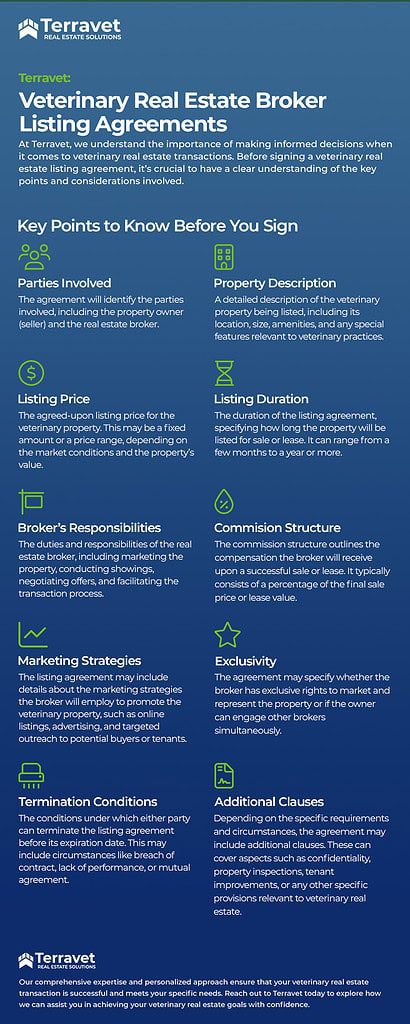At Terravet, we understand the importance of making informed decisions when it comes to veterinary real estate transactions. Before signing a veterinary real estate listing agreement, it’s crucial to have a clear understanding of the key points and considerations involved. In this article, we will walk you through the essentials, from what a veterinary real estate listing agreement entails to negotiating terms and protecting your interests. By being well-informed, you can make confident choices that align with your veterinary real estate goals.
What is a Veterinary Real Estate Listing Agreement?
A veterinary real estate listing agreement is a contractual agreement between a property owner and a real estate broker, specifically tailored to veterinary properties. It outlines the terms and conditions of the property listing, including the broker’s responsibilities, marketing strategies, commission rates, and duration of the agreement.

Key Points in a Veterinary Real Estate Listing Agreement:
A veterinary real estate listing agreement typically consists of several key components that outline the terms and conditions of the property listing. While the specific details may vary, here are the common components found in a veterinary real estate listing agreement:
- Parties Involved: The agreement will identify the parties involved, including the property owner (seller) and the real estate broker.
- Property Description: A detailed description of the veterinary property being listed, including its location, size, amenities, and any special features relevant to veterinary practices.
- Listing Price: The agreed-upon listing price for the veterinary property. This may be a fixed amount or a price range, depending on the market conditions and the property’s value.
- Listing Duration: The duration of the listing agreement, specifying how long the property will be listed for sale or lease. It can range from a few months to a year or more.
- Broker’s Responsibilities: The duties and responsibilities of the real estate broker, including marketing the property, conducting showings, negotiating offers, and facilitating the transaction process.
- Commission Structure: The commission structure outlines the compensation the broker will receive upon a successful sale or lease. It typically consists of a percentage of the final sale price or lease value.
- Marketing Strategies: The listing agreement may include details about the marketing strategies the broker will employ to promote the veterinary property, such as online listings, advertising, and targeted outreach to potential buyers or tenants.
- Exclusivity: The agreement may specify whether the broker has exclusive rights to market and represent the property or if the owner can engage other brokers simultaneously.
- Termination Conditions: The conditions under which either party can terminate the listing agreement before its expiration date. This may include circumstances like breach of contract, lack of performance, or mutual agreement.
- Additional Clauses: Depending on the specific requirements and circumstances, the agreement may include additional clauses. These can cover aspects such as confidentiality, property inspections, tenant improvements, or any other specific provisions relevant to veterinary real estate.
It’s crucial to thoroughly review and understand all the details within the agreement before signing to ensure it aligns with your goals and protects your interests. Consulting with legal professionals or experienced veterinary real estate brokers can provide further guidance and clarity throughout the process.
Benefits and Risks of Signing a Real Estate Listing Agreement for Veterinary Properties:
Signing a real estate listing agreement for veterinary properties offers numerous benefits. These include access to targeted marketing, expertise in the veterinary real estate market, potential buyers within a specialized network, and professional guidance throughout the transaction. However, it’s important to consider potential risks, such as limitations due to exclusivity and the possibility of a prolonged sale process.
Negotiating terms in a veterinary commercial real estate listing agreement allows you to tailor the agreement to your specific needs. Areas to focus on during negotiation may include commission rates, marketing strategies, duration, exclusivity periods, and any specific provisions related to veterinary equipment or fixtures.
To safeguard your interests, seek guidance from Terravet, a trusted veterinary real estate company. Our team of experts can review the listing agreement, provide legal and market insights, and ensure the terms align with your specific goals. We prioritize protecting your interests and maximizing the potential of your veterinary real estate investment.
Conclusion
Before signing a veterinary real estate listing agreement, it’s crucial to thoroughly understand the key points involved. Consider the unique aspects of commercial real estate listing agreements for veterinary properties and actively negotiate terms that align with your goals. Assess the benefits and risks associated with signing such agreements and, most importantly, protect your interests by partnering with Terravet.
Our comprehensive expertise and personalized approach ensure that your veterinary real estate transaction is successful and meets your specific needs. Reach out to Terravet today to explore how we can assist you in achieving your veterinary real estate goals with confidence.



